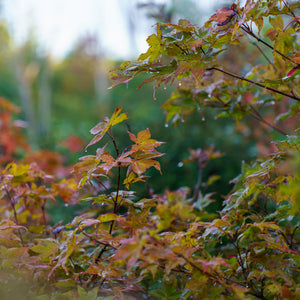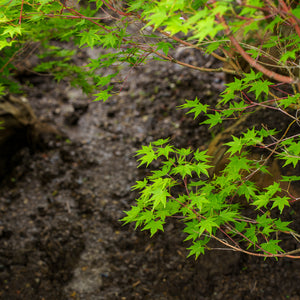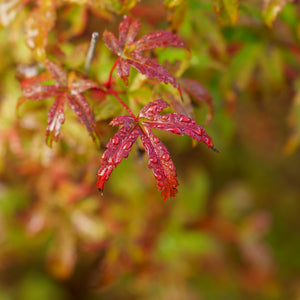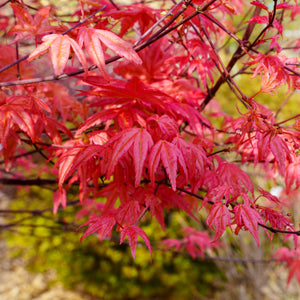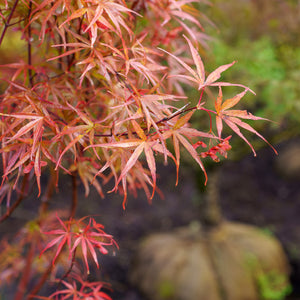The Japanese Maple Guide
Japanese maple trees are prized for their delicate and colorful foliage, making them a popular choice for landscaping and gardening. The leaves of Japanese maples come in a variety of shapes and colors, including red, green, purple, and variegated. Some varieties also have an attractive, cascading form that adds visual interest to any landscape. Japanese maples typically grow to be around 15-25 feet tall, making them an ideal choice for smaller yards or as accent plants in larger landscapes. They are often used as specimen plants, foundation plantings, or in mixed borders. With their unique and eye-catching appearance, Japanese maples are sure to enhance the beauty and appeal of any garden or landscape.
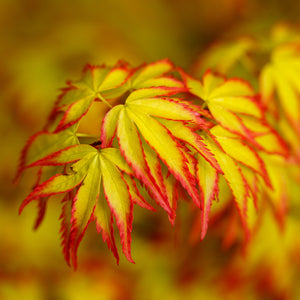
ABOUT
Japanese maple trees, members of the Aceraceae family, are a distinctive group of deciduous trees celebrated for their captivating attributes and rich cultural significance. These trees are indigenous to Japan, Korea, and China, where they have flourished for centuries. Japanese maples are known for their unique foliage, elegant structure, and ornamental value. They bring an air of elegance and history to gardens and landscapes around the world.
One of the most distinguishing features of Japanese maples is their intricately lobed leaves, which emerge in a wide range of shapes and colors. These leaves transform into vibrant shades of red, orange, or yellow in the fall, creating a breathtaking seasonal spectacle. Their delicate and finely cut leaves are a testament to the tree's artistry, adding a touch of grace to any environment. Japanese maples have a remarkable ability to enrich the aesthetic quality of gardens.
These trees exhibit impressive adaptability, which is demonstrated through their ability to thrive in various soil types and environmental conditions. Japanese maples tend to prefer well-draining, slightly acidic soil, but they can adapt to different settings, making them versatile choices for diverse landscapes. Their resistance to many common pests and diseases adds to their appeal for landscaping projects, as they offer both beauty and durability.
Beyond their horticultural importance, Japanese maples hold a unique place in the world of bonsai cultivation. Their small leaves, delicate branches, and fascinating forms make them popular choices for bonsai enthusiasts. Cultivating a Japanese maple as a bonsai allows one to appreciate their beauty and elegance on a miniature scale.
In Japanese culture, these trees are esteemed for their symbolism and artistic inspiration. The Japanese have cultivated various cultivars to emphasize specific traits, including leaf color, leaf shape, and size. They are often integrated into traditional Japanese gardens and courtyard designs, adding a sense of serenity and grace to the surroundings.
By selecting and nurturing Japanese maple trees in your landscape, you enhance the aesthetic appeal of your outdoor space and connect with a rich cultural tradition. Embrace the enduring allure of Japanese maples, and create a garden that exudes both elegance and history.
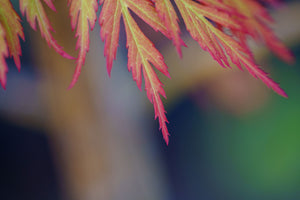
Planting
Japanese maples are known for their unique and delicate foliage and require specific growing conditions to maintain their health and beauty. Here are some general guidelines for planting and caring for Japanese maples:
Soil: Japanese maples prefer well-drained soil that is rich in organic matter. They thrive in slightly acidic to neutral soil with a pH between 5.5 and 7.5. If your soil is too alkaline, you can amend it with sulfur or other acidic materials to lower the pH.
Sunlight: Most Japanese maples prefer partial shade to full sun, depending on the species. They are particularly sensitive to intense sun exposure and may suffer leaf burn. When choosing a location for your Japanese maple, consider the amount of sunlight it will receive throughout the day.
Watering: Japanese maples require regular watering, especially during their first few years of growth. Water deeply and thoroughly once or twice a week, depending on the weather and soil moisture levels. Be careful not to overwater, as Japanese maples can be susceptible to root rot in soggy soil.
Mulching: Mulch around the base of your Japanese maple tree or shrub to help retain moisture and regulate soil temperature. Use a layer of organic material such as wood chips, bark, or compost, and keep the mulch a few inches away from the trunk to prevent moisture buildup.
Pruning: Japanese maples require regular pruning to maintain their shape and size. Prune in late winter or early spring before the new growth appears. Avoid pruning during the summer months, as this can cause damage to the tree.
By following these basic guidelines, you can ensure that your Japanese maple tree or shrub thrives and adds beauty to your landscape for years to come.

Care
Japanese maples are relatively low-maintenance plants but still require specific care to promote their healthy growth and vibrant colors. Here are some general guidelines for caring for Japanese maple:
Watering: Japanese maples need regular watering, especially during their first few years of growth. Water deeply and thoroughly once or twice a week, depending on the weather and soil moisture levels. Be careful not to overwater, as this can lead to root rot and other issues.
Pruning: Japanese maples require minimal pruning, mainly to remove dead or damaged branches or to shape the plant's size and form. Prune during the winter dormancy period to encourage new growth in the spring.
Fertilizing: Fertilizing can help promote healthy growth and foliage color in Japanese maples. Use a slow-release, balanced fertilizer in the spring or early summer, following the manufacturer's instructions for application rates and timing. Avoid over-fertilizing, as this can harm the plant.
Mulching: Mulch around the base of your Japanese maple to help retain moisture, regulate soil temperature, and prevent weed growth. Use a layer of organic material such as wood chips, bark, or compost, and keep the mulch a few inches away from the trunk to prevent moisture buildup.
With these care guidelines, your Japanese maple can thrive and add beauty to your landscape for years to come.
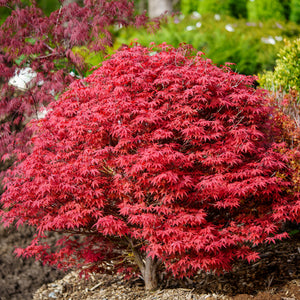
How To Use
Japanese maple trees are versatile and can be used in various ways to enhance your landscape. Here are some recommendations based on their characteristics:
Focal Point: Japanese maples possess a captivating presence, making them an ideal choice as a focal point in your landscape. Plant a single Japanese maple in a prominent location to showcase its elegant form, vibrant foliage, and unique branching structure. Whether it's in a front yard, near an entrance, or as the centerpiece of a garden, it will draw attention and create a striking focal point.
Shade Tree: With their beautifully layered canopies, Japanese maples provide excellent shade. Plant them strategically near outdoor seating areas, patios, or decks to create a cool and comfortable space where you can relax and enjoy the outdoors. Their dappled shade adds a serene atmosphere to your outdoor living areas. Consider underplanting with shade-loving companions like ferns or hostas for added beauty.
Courtyard or Garden Design: Japanese maples are often used in traditional Japanese courtyard and garden designs. Their gracefully cascading branches and colorful leaves add a sense of tranquility and timeless beauty. Plant them as a centerpiece in a courtyard or as part of a well-thought-out garden design to create a peaceful retreat in your outdoor space.
Container Planting: Due to their manageable size and striking appearance, many Japanese maples are suitable for growing in containers. This allows you to enjoy their beauty on patios, balconies, or in small urban gardens. Choose a well-draining potting mix and ensure the container has drainage holes to prevent waterlogging.
Accent Trees in Mixed Borders: In mixed borders or island beds, Japanese maples work as accent trees, adding a touch of elegance to the overall design. Their vibrant foliage and varying shapes can complement and contrast with other shrubs and perennials, creating visual interest throughout the year.
Bonsai: Japanese maples are popular choices for bonsai enthusiasts. Their small leaves and graceful branching structure are well-suited for creating intricate bonsai designs. Growing a Japanese maple as a bonsai allows you to appreciate their beauty on a smaller scale and develop your skills in the art of bonsai cultivation.
Lighting and Sculptural Effects: Consider adding landscape lighting to highlight the form and foliage of your Japanese maple trees in the evening. Uplights or well-placed garden lighting can create dramatic effects and showcase their elegance even after dark.
When incorporating Japanese maples into your landscape, consider the specific variety and its growth habit, as there are many to choose from. Additionally, ensure that they are planted in areas with well-drained, slightly acidic soil and the right amount of sunlight, according to the variety's requirements. With their unique forms and stunning foliage, Japanese maples are a versatile and exceptional addition that will enhance the beauty and functionality of your outdoor environment.
Conclusion
In the world of landscaping and garden design, Japanese maple trees offer an enduring elegance and a touch of history to your outdoor space. Their unique and finely textured leaves, combined with vibrant autumnal transformations, add an exceptional aesthetic appeal to any landscape. Beyond their ornamental charm, these trees are hardy, adaptable, and resistant to many common pests and diseases, making them ideal choices for diverse environments.
Japanese maples, with their deep-rooted cultural significance, have inspired art, design, and traditional Japanese gardens for centuries. Their role in bonsai culture adds another layer of appreciation to their captivating attributes. Whether they stand as ornamental focal points or complement mixed plantings, Japanese maple trees bring an enduring sense of grace and history to your garden.
By selecting, planting, and nurturing Japanese maple trees, you not only enhance the beauty of your outdoor space but also connect with a cultural tradition and historical lineage. Embrace the captivating allure of Japanese maples and create a garden that reflects both elegance and heritage. Cultivate your landscape with Japanese maples and enjoy the beauty and significance they bring to your outdoor environment for years to come.




